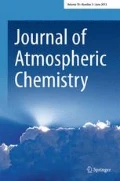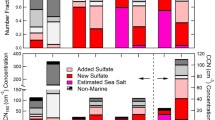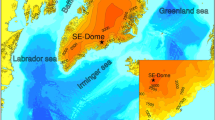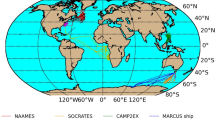Abstract
Vertical distributions of dimethylsulfide (DMS), sulfur dioxide (SO2), aerosol methane-sulfonate (MSA), non-sea-salt sulfate (nss-SO4 2-), and other aerosol ions were measured in maritime air west of Tasmania (Australia) during December 1986. A few cloudwater and rainwater samples were also collected and analyzed for major anions and cations. DMS concentrations in the mixed layer (ML) were typically between 15–60 ppt (parts per trillion, 10−12; 24 ppt=1 nmol m−3 (20°C, 1013 hPa)) and decreased in the free troposphere (FT) to about <1–2.4 ppt at 3 km. One profile study showed elevated DMS concentrations at cloud level consistent with turbulent transport (‘cloud pumping’) of air below convective cloud cells. In another case, a diel variation of DMS was observed in the ML. Our data suggest that meteorological rather than photochemical processes were responsible for this behavior. Based on model calculations we estimate a DMS lifetime in the ML of 0.9 days and a DMS sea-to-air flux of 2–3 μmol m−2 d−1. These estimates pertain to early austral summer conditions and southern mid-ocean latitudes. Typical MSA concentrations were 11 ppt in the ML and 4.7–6.8 ppt in the FT. Sulfur-dioxide values were almost constant in the ML and the lower FT within a range of 4–22 ppt between individual flight days. A strong increase of the SO2 concentration in the middle FT (5.3 km) was observed. We estimate the residence time of SO2 in the ML to be about 1 day. Aqueous-phase oxidation in clouds is probably the major removal process for SO2. The corresponding removal rate is estimated to be a factor of 3 larger than the rate of homogeneous oxidation of SO2 by OH. Model calculations suggest that roughly two-thirds of DMS in the ML are converted to SO2 and one-third to MSA. On the other hand, MSA/nss-SO4 2- mole ratios were significantly higher compared to values previously reported for other ocean areas suggesting a relatively higher production of MSA from DMS oxidation over the Southern Ocean. Nss-SO4 2- profiles were mostly parallel to those of MSA, except when air was advected partially from continental areas (Africa, Australia). In contrast to SO2, nss-SO4 2- values decreased significantly in the middle FT. NH4 +/nss-SO4 2- mole ratios indicate that most non-sea-salt sulfate particles in the ML were neutralized by ammonium.
Similar content being viewed by others
References
Andreae, M. O., 1986, The ocean as a source of atmospheric sulfur compounds, in P., Buat-Menard (ed.), The Role of Air-Sea Exchange in Geochemical Cycling, D. Reidel, Dordrecht, pp. 331–362.
Andreae, M. O., 1982, Marine aerosol chemistry at Cape Grim, Tasmania, and Towsville, Queensland, J. Geophys. Res. 87, 8875–8885.
Andreae, M. O., Berresheim, H., Andreae, T. W., Kritz, M. A., Bates, T. S., and Merrill, J. T., 1988, Vertical distribution of dimethylsulfide, sulfur dioxide, aerosol ions, and radon over the northeast Pacific Ocean, J. Atmos. Chem. 6, 149–173.
Andreae, M. O., Charlson, R. J., Bruynseels, F., Storms, H., van, Grieken, R., and Maenhaut, W., 1986, Internal mixture of sea salt, silicate, and excess sulfate in marine aerosols, Science 232, 1620–1623.
Andreae, M. O., Ferek, R. J., Bermond, F., Byrd, K. P., Engstrom, R. T., Hardin, S., Houmere, P. D., LeMarrec, F., Raemdonck, H., and Chatfield, R. B., 1985, Dimethyl sulfide in the marine atmosphere, J. Geophys. Res. 90, 12891–12900.
Atkinson, R., Pitts, J. N., and Aschmann, S. M., 1984, Tropospheric reactions of dimethyl sulfide with NO3 and OH radicals, J. Phys. Chem. 88, 1584–1587.
Ayers, G. P. and Ivey, J. P., 1989, Methanesulfonate in rainwater at Cape Grim, Tasmania, Tellus B, (in press).
Ayers, G. P. and Gillett, R. W., 1988, First observations of cloudwater acidity in tropical Australia, Clean Air (Aust.) 22, 53–57.
Ayers, G. P., Ivey, J. P., and Goodman, H. S., 1986, Sulfate and methanesulfonate in the maritime aerosol at Cape Grim, Tasmania, J. Atmos. Chem. 4, 173–185.
Ayers, G. P. and Gras, J. L., 1983, The concentration of ammonia in Southern Ocean air, J. Geophys. Res. 88, 10655–10659.
Barnes, I., Becker, K. H., Martin, D., Carlier, P., Mouvier, G., Jourdain, J. L., Laverdet, G., and LeBras, G., 1989, The impact of halogen oxides on DMS oxidation in the marine atmosphere, in E. S. Saltzman and W. J. Cooper (eds.), Biogenic Sulfur in the Environment, Am. Chem. Soc. Sympos. Ser., Vol. 393, pp. 464–475.
Barnes, I., Bastian, V., and Becker, K. H., 1988, Kinetics and mechanisms of the reaction of OH radicals with dimethyl sulfide, Int. J. Chem. Kinet. 20, 415–431.
Barnes, I., Becker, K. H., Carlier, P., and Mouvier, G., 1987, FTIR study of the DMS/NO2/I2/N2 photolysis system: The reaction of IO radicals with DMS, Int. J. Chem. Kinet. 19, 489–501.
Bates, T. S., Charlson, R. J., and Gammon, R. H., 1987a, Evidence for the climatic role of marine biogenic sulphur, Nature 329, 319–321.
Bates, T. S., Cline, J. D., Gammon, R. H., and Kelly-Hansen, S. R., 1987b, Regional and seasonal variations in the flux of oceanic dimethylsulfide to the atmosphere, J. Geophys. Res. 92, 2930–2938.
Berresheim, H., Andreae, M. O., Ayers, G. P., and Gillett, R. W., 1989, Distribution of biogenic sulfur compounds in the remote Southern Hemisphere, in E. S. Saltzman and W. J. Cooper (eds.), Biogenic Sulfur in the Environment, Am. Chem. Soc. Sympos. Ser., Vol. 393, pp. 352–366.
Berresheim, H., 1987, Biogenic sulfur emissions from the Subantarctic and Antarctic oceans, J. Geophys. Res. 92, 13245–13262.
Brimblecombe, P. and Dawson, G. A., 1984, Wet removal of highly soluble gases, J. Atmos. Chem. 2, 95–107.
Calvert, J. G. and Stockwell, W. R., 1984, The mechanism and rates of the gas phase oxidation of sulfur dioxide and nitrogen oxides in the atmosphere, in J. I., Teasley and J. G., Calvert (eds), SO 2, NO, and NO 2 Oxidation Mechanisms: Atmospheric Considerations, Butterwoth, Stoneham, MA, 1984, 1–62.
Chameides, W. L., 1984, The photochemistry of a remote marine stratiform cloud, J. Geophys. Res. 89, 4739–4755.
Charlson, R. J., Lovelock, J. E., Andreae, M. O., and Warren, S. G., 1987, Oceanic phytoplankton, atmospheric sulphur, cloud albedo and climate, Nature, 326, 655–661.
Chatfield, R. B. and Crutzen, P. J., 1984, Sulfur dioxide in remote tropospheric air: Cloud transport of reactive precursors, J. Geophys. Res. 89, 7111–7132.
Chatfield, R. B. and Crutzen, P. J., 1989, Interactions of iodine and sulfur species in marine air photochemistry: DMSO, SO4 2- may indicate low IO, J. Geophys. Res. (submitted).
Clarke, A. D., Ahlquist, N. C., and Covert, D. S., 1987, The Pacific marine aerosol: Evidence for natural acid sulfates, J. Geophys. Res. 92, 4179–4190.
Costen, R. C., Tennille, G. M., and Levine, J. S., 1988, Cloud pumping in a one-dimensional photochemical model, J. Geophys. Res. 93, 15941–15954.
Daum, P. H., Schwartz, S. E., and Newman, L., 1984, Acidic and related constituents in liquid water stratiform clouds, J. Geophys. Res. 89, 1447–1458.
Daykin, E. P. and Wine, P. H., 1989, Kinetics studies of some reactions of the IO radical with potential importance in atmospheric chemistry, (abstract), Second International Conference on Chemical Kinetics, July 24–27, National Institute of Standards and Technology, Gaithersburg, U.S.A., p. 97.
Ferek, R. J., Chatfield, R. B., and Andreae, M. O., 1986, Vertical distribution of dimethylsulfide in the marine atmosphere, Nature 320, 514–516.
Galloway, J. N., 1985, Deposition of sulfur and nitrogen from the remote atmosphere: Background paper, in J. N., Galloway, R. J., Charlson, M. O., Andreae, and H., Rodhe (eds.), The Biogeochemical Cycling of Sulfur and Nitrogen in the Remote Atmosphere, D. Reidel, Dordrecht, pp. 142–175.
Gras, J. L., 1983, Ammonia and ammonium concentrations in the Antarctic atmosphere, Atmos. Environ. 17, 815–818.
Gras, J. L. and Ayers, G. P., 1983, Marine aerosol at southern mid-latitudes, J. Geophys. Res. 88, 10661–10666.
Harvey, G. R. and Lang, R. F., 1986, Dimethylsulfoxide and dimethylsulfone in the marine atmosphere, Geophys. Res. Lett. 13, 49–51.
Hatakeyama, S., Izumi, K. and Akimoto, H., 1985, Yield of SO2 and formation of aerosol in the photo-oxidation of DMS under atmospheric conditions, Atmos. Environ. 19, 135–141.
Hicks, B. B. and Liss, P. S., 1976, Transfer of SO2 and other reactive gases across the air-sea interface, Tellus 28, 348–354.
Holton, J. R., 1979, An Introduction to Dynamic Meterology, Academic Press, New York, Chapter 2.
Hoppel, W. A., 1987, Nucleation in the MSA-water vapor system, Atmos. Environ., 21, 2703–2709.
Huebert, B. J. and Lazrus, A. L., 1980, Tropospheric gas-phase and particulate nitrate measurements, J. Geophys. Res. 85, 7322–7328.
Hynes, A. J., Wine, P. H., and Semmes, D. H., 1986, Kinetics and mechanisms of OH reactions with organic sulfides, J. Phys. Chem. 90, 4148–4156.
Ivey, J. P., Davies, D. M., Morgan, V., and Ayers, G. P., 1986, Methanesulphonate in Antarctic ice, Tellus 38B, 375–379.
Jitts, H. R., 1965, The summer characteristics of primary productivity in the Tasman and Coral Seas, Aust. J. Mar. Freshw. Res. 16, 151–162.
Keene, W. C. and Galloway, J. N., 1987, Considerations regarding sources for formic and acetic acids in the troposphere, J. Geophys. Res. 91, 14466–14474.
Kolaitis, L. N., Bruynseels, F. J., van, Grieken, R. E., and Andreae, M. O., 1989, Determination of methanesulfonic acid and non-sea-salt sulfate in single marine aerosol particles, Environ. Sci. Technol. 23, 236–240.
Kreidenweis, S. M. and Seinfeld, J. H., 1988, Nucleations of sulfuric acid-water and methanesulfonic acid-water solution particles: Implications for the atmospheric chemistry of organosulfur species, Atmos. Environ. 22, 283–296.
Kritz, M. A., 1982, Exchange of sulfur between the free troposphere, marine boundary layer, and the sea surface, J. Geophys. Res. 87, 8795–8803.
Kritz, M. A., 1983, Use of long-lived radon daughters as an indicator of exchange between the free troposphere and marine boundary layer, J. Geophys. Res. 88, 8569–8573.
Legrand, M. and Saigne, C., 1988, Formate, acetate, and methanesulfonate measurements in Antarctic ice: Some geochemical implications, Atmos. Environ. 22, 1011–1017.
Logan, J. A., Prather, M. J., Wofsy, S. C., and McElroy, M. B., 1981, Tropospheric chemistry: A global perspective. J. Geophys. Res. 86, 7210–7254.
Maroulis, P. J., Torres, A. L., Goldberg, A. B., and Bandy, A. R., 1980, Atmospheric SO2 measurements on project GAMETAG, J. Geophys. Res. 85, 7345–7349.
Merrill, J. T., Bleck, R.,and Avila, L., 1985, Modeling atmospheric transport to the Marshall Islands, J. Geophys. Res. 90, 12,927–12,936.
Mopper, K. and Zika, R. G., 1987, Free amino acids in marine rains: Evidence for oxidation and potential role in nitrogen cycling, Nature, 325, 246–249.
Ockelmann, G., 1988, Grossraeumige Verteilung des atmosphaerischen Schwefeldioxids in der Troposphaere und unteren Stratosphaere — Ergebnisse einer experimentellen Untersuchung, Ber. Inst. f. Meteorol. u. Geophys., 75, University of Frankfurt, FRG.
Pszenny, A. A. P., A. J., Castelle, J. N., Galloway, and R. A., Duce, 1989, A study of the sulfur cycle in the Antarctic marine boundary layer, J. Geophys. Res. 94, 9818–9830.
Quinn, P. K. and Bates, T. S., 1989, Collection efficiencies of a tandem sampling system for atmospheric aerosol particles and gaseous ammonia and sulfur dioxide, Environ. Sci. Technol. 23, 736–739.
Quinn, P. K., Charlson, R. J., and Bates, T. S., 1988a, Simultaneous observations of ammonia in the atmosphere and ocean, Nature, 335, 336–338.
Quinn, P. K., Bates, T. S., and Charlson, R. J., 1988b, Ammonia species and non-sea-salt sulfate in the remote atmosphere and the ocean as a function of latitude, EOS (abstract) 69, 1075.
Saltzman, E. S. and Cooper, D. J., 1989, Dimethyl sulfide and hydrogen sulfide in marine air, in E. S. Saltzman and W. J. Cooper (eds.), Biogenic Sulfur in the Environment, Am. Chem. Soc. Sympos. Ser., Vol. 393, pp. 330–351.
Saltzman, E. S., Savoie, D. L., Zika, R. G., and Prospero, J. M., 1983, Methane sulfonic acid in the marine atmosphere, J. Geophys. Res. 88, 10897–10902.
Savoie, D. L., and Prospero, J. M., 1989, Comparison of oceanic and continental sources of non-sea-salt sulphate over the Pacific Ocean, Nature 339, 685–687.
Schwartz, S. E., 1988, Are global cloud albedo and climate controlled by marine phytoplankton?, Nature 336, 441–445.
Slinn, S. A. and Slinn, W. G. N., 1981, Modeling of atmospheric particulate deposition to natural waters, in S. G. Eisenrich (ed.), Atmospheric Pollutants and Natural Waters, Ann Arbor, MI, pp. 23–53.
Thompson, A. M. and Lenschow, D. H., 1984, Mean profiles of trace reactive species in the unpolluted marine surface layer, J. Geophys. Res. 89, 4788–4796.
Thornton, D. C., Bandy, A. R., and Driedger III, A. R., 1987, Dimethyl sulfide, sulfur dioxide, and carbon disulfide over the southern Pacific Ocean, Preprints 194th National Meeting, Biogenic Sulfur in the Environment, American Chemical Society, p. 260.
Toon, O. B., Kasting, J. B., Turco, R. P., and Liu, M. S., 1987, The sulfur cycle in the marine atmosphere, J. Geophys. Res. 92, 943–964.
Van, Valin, C. C., Berresheim, H., Andreae, M. O., and Luria, M., 1987, Dimethyl sulfide over the western Atlantic Ocean, Geophys. Res. Lett. 14, 715–718.
Watts, S. F., Watson, A., and Brimblecombe, P., 1987, Measurements of the aerosol concentrations of methanesulfonic acid, dimethyl sulfoxide and dimethyl sulphone in the marine atmosphere of the British Isles, Atmos. Environ. 21, 2667–2672.
Author information
Authors and Affiliations
Rights and permissions
About this article
Cite this article
Berresheim, H., Andreae, M.O., Ayers, G.P. et al. Airborne measurements of dimethylsulfide, sulfur dioxide, and aerosol ions over the Southern Ocean South of Australia. J Atmos Chem 10, 341–370 (1990). https://doi.org/10.1007/BF00053868
Received:
Issue Date:
DOI: https://doi.org/10.1007/BF00053868




